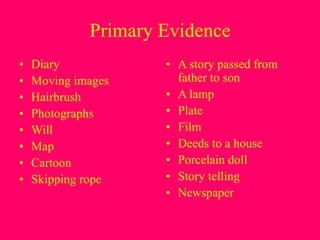Sources of history
- 1. Evidence L.O To understand the difference between primary and secondary evidence
- 2. • Imagine you are a detective investigating a crime. • What would you need to find out what happened? • What would you be looking for when you went to the scene of the crime? • That’s right clues • and evidence! • Well historians are • no different
- 3. • When Historians want to find out what happened in the past they look for evidence. • We call evidence that was created at the time of the event PRIMARY • Letters • Newspapers • Maps • Magazines • Photographs • Objects • These some of the forms of • Primary Evidence
- 4. • When Historians want to find out what happened in the past they look for evidence.
- 5. Primary Evidence • Primary Evidence can be broken down into 4 categories- • Written sources • Images • Oral Testimony • Artefacts
- 6. • Primary sources • ♦ Are original documents and contemporary accounts of an event written by either someone who experienced the event or someone who witnessed the event. • ♦ Are anything that has been stated/created by someone but not interpreted by others. • Eg: • diaries, speeches, letters, interviews, poems, plays, novels, short stories, music, art, photographs, pottery, etc.
- 7. • Secondary sources • ♦ Are sources written about primary sources that analyze, interpret, and discuss the primary source. • Eg: • journal articles, books, reviews, newspaper articles, essays, magazines, textbooks, histories, etc.
- 8. Over to you • Draw the table into your book • Put the pieces of evidence in the correct categories. Written Sources Oral Testimonies Images Artefacts
- 9. Primary Evidence • Diary • Moving images • Hairbrush • Photographs • Will • Map • Cartoon • Skipping rope • A story passed from father to son • A lamp • Plate • Film • Deeds to a house • Porcelain doll • Story telling • Newspaper
- 10. Secondary Evidence • What is the first thing you do when you want to find out about what happened in the past? • Most people would probably say that they would look in a book, ask a teacher or other expert or check it out on the internet. • These are all excellent sources of information. • Resources like this can tell us not only historical facts but we can also use them to find out what other people think about what happened, in other words their interpretation of history.
- 11. Your account • Write your own account of something that has happened in your life. • For example, a birthday, holiday or trip to a theme park. • Describe what primary and secondary evidence you have to prove this event happened in the past.











